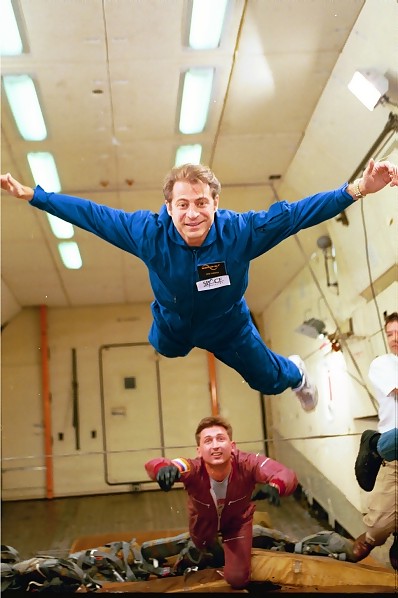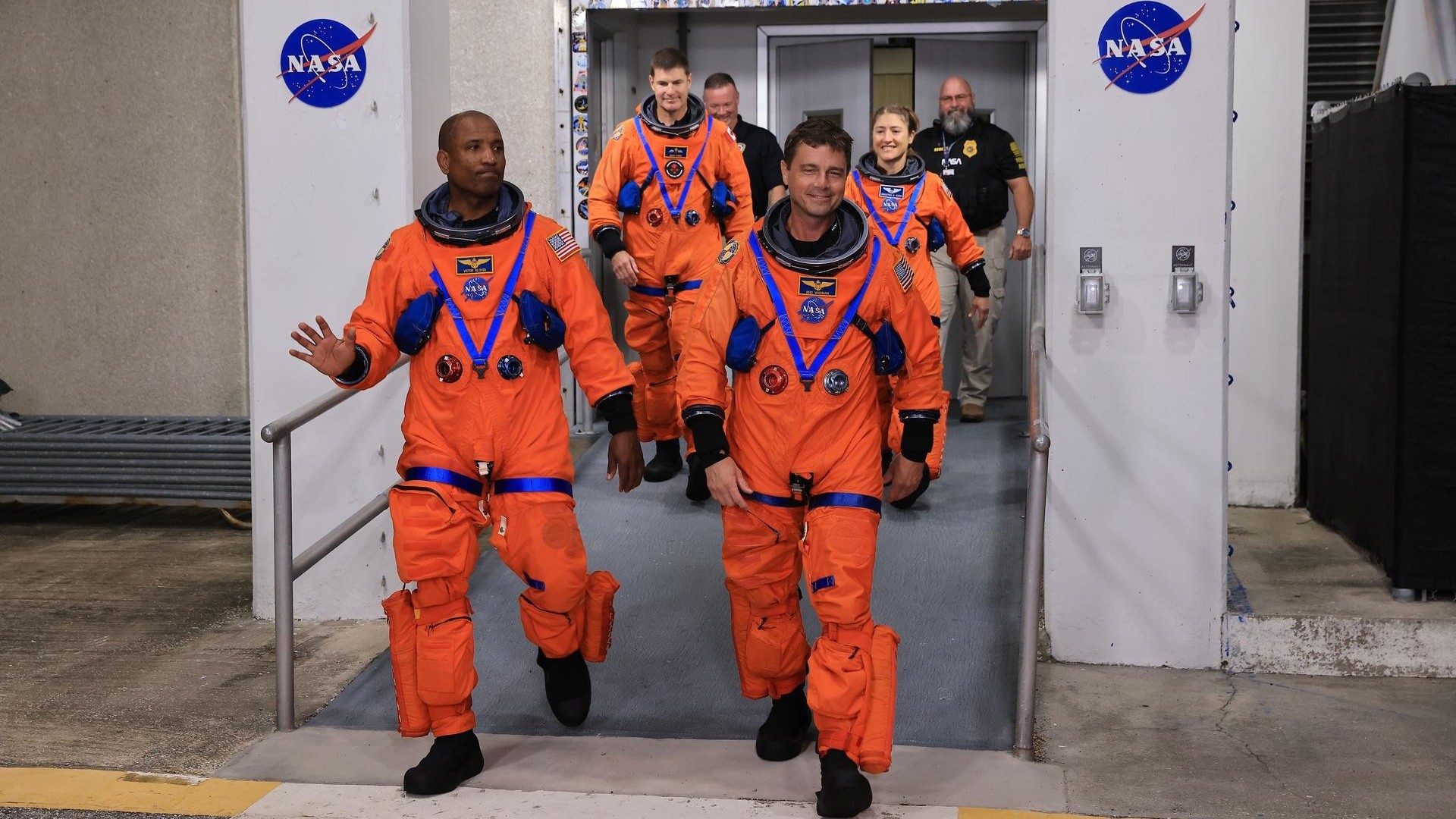Vacations In Zero Gravity Come of Age

This story was updated at 3:00 p.m. ET.
As the Fourthof July holiday weekend approaches, American families may be preparing forbarbecues, picnics and days at the beach. But what about taking a trip highinto the sky and experiencing what it would feel like to be in space, on themoon, or on Mars?
At least onefamily will be doing just that ? spending part of their Independence Dayweightless. Sound farfetched? These types of "family vacations" maysoon be more commonplace than you think.
Thisweekend, Alan Stern, Associate Vice President at the Southwest ResearchInstitute (SwRI), is taking his wife and three children aboard Zero GravityCorporation's G-Force One aircraft to experience what it feels like to be in anenvironment of true weightlessness.
Sternis leading a new project at SwRI that looks into the science applications ofsuch aircraft and other next-generation suborbital space vehicles, and istaking part in the flight as part of that venture. [10 PrivateSpaceships Becoming Reality]
A weightless family affair
Stern is aveteran planetary scientist and former NASA science chief, and currently servesas the principal investigator for NASA's New Horizons probe headed for Pluto.He has flown on weightless flights several times and hopes that the Zero-Gexperience will give his family a small taste of what his own experiences were like.
Breaking space news, the latest updates on rocket launches, skywatching events and more!
"Noneof my kids or my wife is in the space world, and I thought this was somethingthat I'd like to do for them, and do as a group," Stern told SPACE.com.
Currently,Zero-G flights depart from three primary locations: Las Vegas, Nev., CapeCanaveral, Fla., and Titusville, Fla. The company also occasionally schedulesflights in other cities, including Seattle, Wash., Los Angeles, Calif., Washington,D.C. and New York.
Flightsstart at $4,950 per person, and while that figure is significantly less thanseats on suborbital flights, it is still a hefty amount. Stern himself saidthat he would not normally be in a position to afford five tickets for the Zero-Gexperience, without the involvement of his research firm. But, as the industryexpands, and as demand grows, the cost of these flights could go down.
The morningof the flight, all 36 passengers will register and meet for a safety briefing and45-minute training session. They will receive instructions on safety issues andwhat to expect from the flight.
Stern andhis family will depart from Dulles International Airport in Washington, D.C.
The flightplan, with a modified Boeing aircraft, is comprised of a series of 12-15parabolic arcs, which mimic various states of microgravity. The skilled pilots performthese aerobatic maneuvers at different altitudes and at different angles inorder to create the "pulls" of the various gravitational states.
"Thefirst parabola is a Martian parabola, which will give the flyers a 35-secondperiod of Martian gravity," Peter Diamandis, one of thecompany's three founders, told SPACE.com. "So, they'll go from 1 G (theamount of gravity measured on Earth) to 1/3 G."
The next twoparabolas replicate lunar gravity (1/6 G), so the passengers can experiencewhat it feels like to walk on the moon. Subsequently, the aircraft will executea series of 12 parabolas at zero gravity. Passengers on board will be able toperform basic experiments and fun activities whileweightless.
Extremetourism
Zero-G wasfounded by Peter Diamandis, founder and chairman of the X Prize Foundation,veteran astronaut Byron Lichtenberg and NASA engineer Ray Cronise.
It took thetrio 11 years to obtain Federal Aviation Administration (FAA) approval to flywhat are known as commercial parabolic flights aboard their G-Force Oneaircraft ? a special, modified Boeing 727-200.
Zero-G flewits inaugural commercial flight in October 2004, solidifying its position inthe extreme tourism industry as one of the only commercial enterprises thatprovides zerogravity flights that are available to the general public. In 2008, the Virginia-basedfirm Space Adventures ? which offers suborbital, orbital and lunar spaceflights ? purchased thecompany.
The flightshave attracted some celebrity passengers as well, among them Martha Stewart andfamed astrophysicist Stephen Hawking.
"Sincewe launched in 2004, we've flown over 6,000 people in Zero-G," Diamandissaid. "It's wonderful to have it up and operating. The main challenge ishaving people know that it's real and available to them. A lot of people don'tknow it's an option that they have."
In addition,the company provides services for science research and development. In January2008, NASA awarded a contract to Zero-G to provide commercial parabolic flightsfor scientific work. The company has, however, been met with some criticismover its services from a NASA oversight group.
In response to the NASA audit, Zero-G officials said the company has delivered a safe, reliable and cost-effective service to the space agency and "remains committed to continuing to improve its microgravity quality and looks forward to working with NASA to make the Microgravity Flight Services program a model for success in future partnerships with the commercial space industry."
Still,extreme tourism is a relatively new phenomenon. And while Zero-G's flights neverleave Earth's orbit, the commercial enterprise is part of a larger paradigm ofthe expanding horizon of private-sector space efforts and commercialspaceflight.
Reachingfor the stars
In a recentpoll conducted by the Pew Research Center, 1,546 adults (18 years of age orolder) living in the continental U.S. expressed how they envisioned life in theyear 2050. The results of the survey revealed that 53 percent believe that overthe course of the next 40 years, ordinary people will travel in space.
And, that iscertainly within the realm of possibility, said Bretton Alexander, president ofthe Commercial Spaceflight Federation.
"Wehave ordinary, rich citizens flying in space now, but very few of them becausethey are very expensive," Alexander told SPACE.com. "For the ordinaryperson of more modest means, it might be a couple decades, but it certainlyshould be in the next 40 years. In my mind, it's not if it's going to happen,it's when."
In fact,Space Adventures and Zero Gravity, Corp., aren't alone in their space tourismendeavors. British billionaire Sir Richard Branson is planning to launch spacetourists on suborbital spaceflights aboard a spacecraft called SpaceShipTwo ?the first of which is already built and undergoing shakedown tests.
Otherprivate companies have plans for commercialspacecraft, rockets and ? in the case of hotelier Robert Bigelow's BigelowAerospace ? private space stations.
And when ithappens, Stern believes that commercial spaceflight has the potential to berevolutionary.
"I hopethat commercial spaceflight is the equivalent for human spaceflight as the PCrevolution was for computing," Stern said. "Computing used to be bigmachines, and no one could afford them except for government, and computing washard, rare and distant. Then, in the '90s, it became ubiquitous."
Spaceflightcould experience the same transformation. But, the exact manner of thattransformation is more difficult to predict.
"Tourismis the first application, but it's probably not the best or the last,"Stern said. "When personal computers exploded on the scene, people thoughtof computers in the home as a way to do number crunching, keep files or playgames. Nobody had an inkling of how we use the web today. I think spaceflightmay go through the same thing."
Not justa joyride
Still, spacetourism is only a part of commercial suborbital and orbital spaceflight. An equallyvaluable and potentially even more lucrative option is in providing flights forscience and educative purposes.
Zero-G isalready strongly committed to this burgeoning market, and currently has apartnership with Northrop Grumman as well as with NASA. With suborbital and orbital flights, inparticular, these commercial operations could help fill any gaps created afterNASA retires its space shuttle fleet.
"Thebusiness base actually goes beyond tourism," Alexander explained."It's the research flights that will really open up the realm of space formore activities. And I think you'll see that same model with orbital spacetourism."
One smallstep
And fromthere, the possibilities for growth are seemingly limitless.
"Thecapabilities may start with NASA, but then you have foreign governments,sovereign markets and other countries that didn't develop human spaceflightcapabilities that will buy a ride," Alexander said. "Then you haveresearch markets, pharmaceutical companies, manufacturing companies, so it'sanybody's guess as to which of those markets are going to be drivers in how bigthey are."
Still, whilethis type of growth and expansion is not far from Stern's mind, the focus ofthis weekend's Zero-G flight for him is to provide an extraordinary experiencefor his family.
"I hopeI open peoples' eyes to the possibilities that are out there," Stern said."I think my kids ? 30 to 40 years from now, they'll probably look back,and their friends will be amazed that they got to fly in zero gravity so early."
- Top 10 Fantasy Spaceships BecomingReality
- 6 Private Companies That Could LaunchHumans Into Space
- IsThere Gravity In Space?
Visit SPACE.com on Friday, July2 to get a first-hand account from the Stern family as it prepares for itsFourth of July zero gravity vacation.
Join our Space Forums to keep talking space on the latest missions, night sky and more! And if you have a news tip, correction or comment, let us know at: community@space.com.

Denise Chow is a former Space.com staff writer who then worked as assistant managing editor at Live Science before moving to NBC News as a science reporter, where she focuses on general science and climate change. She spent two years with Space.com, writing about rocket launches and covering NASA's final three space shuttle missions, before joining the Live Science team in 2013. A Canadian transplant, Denise has a bachelor's degree from the University of Toronto, and a master's degree in journalism from New York University. At NBC News, Denise covers general science and climate change.
